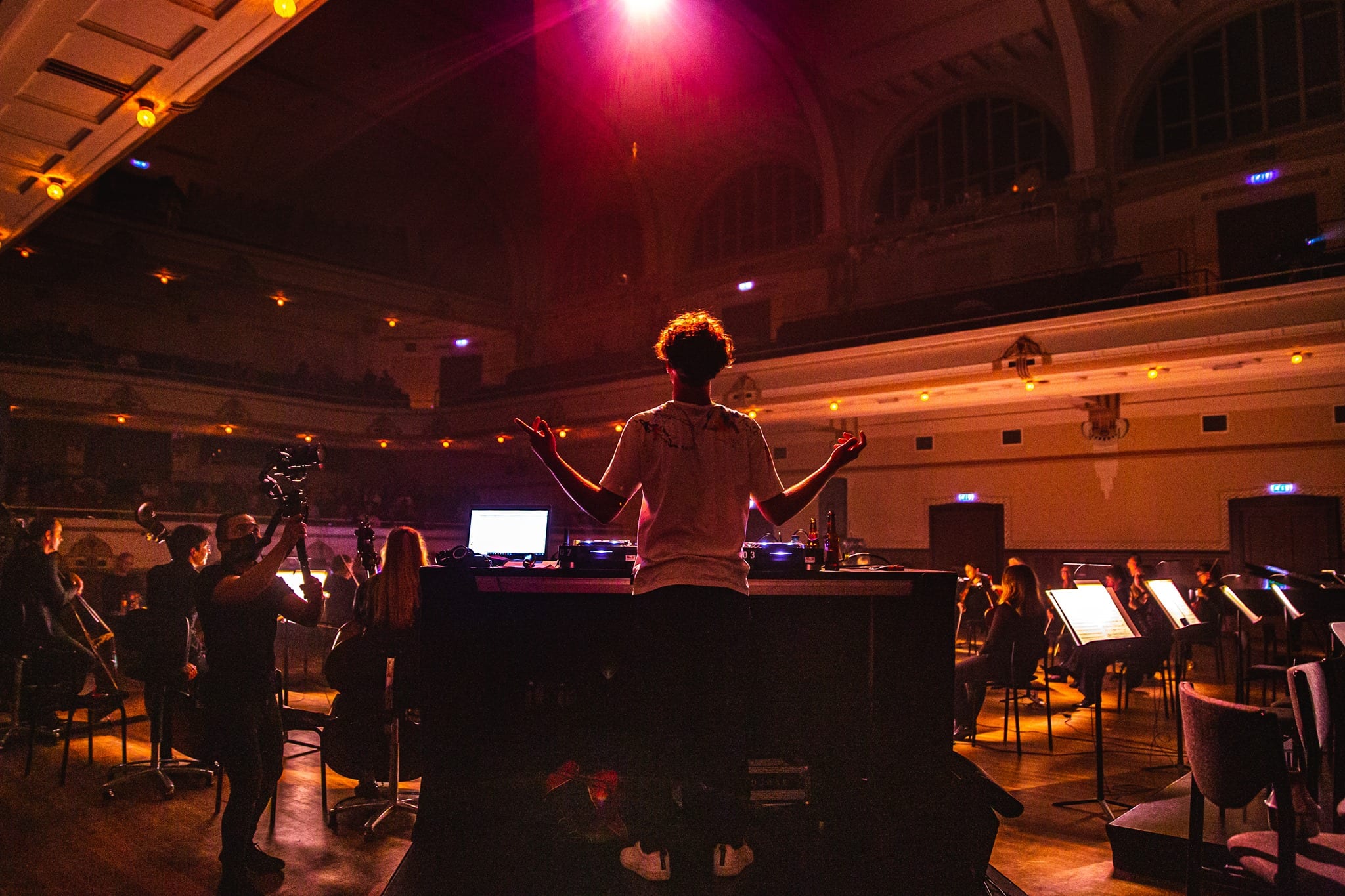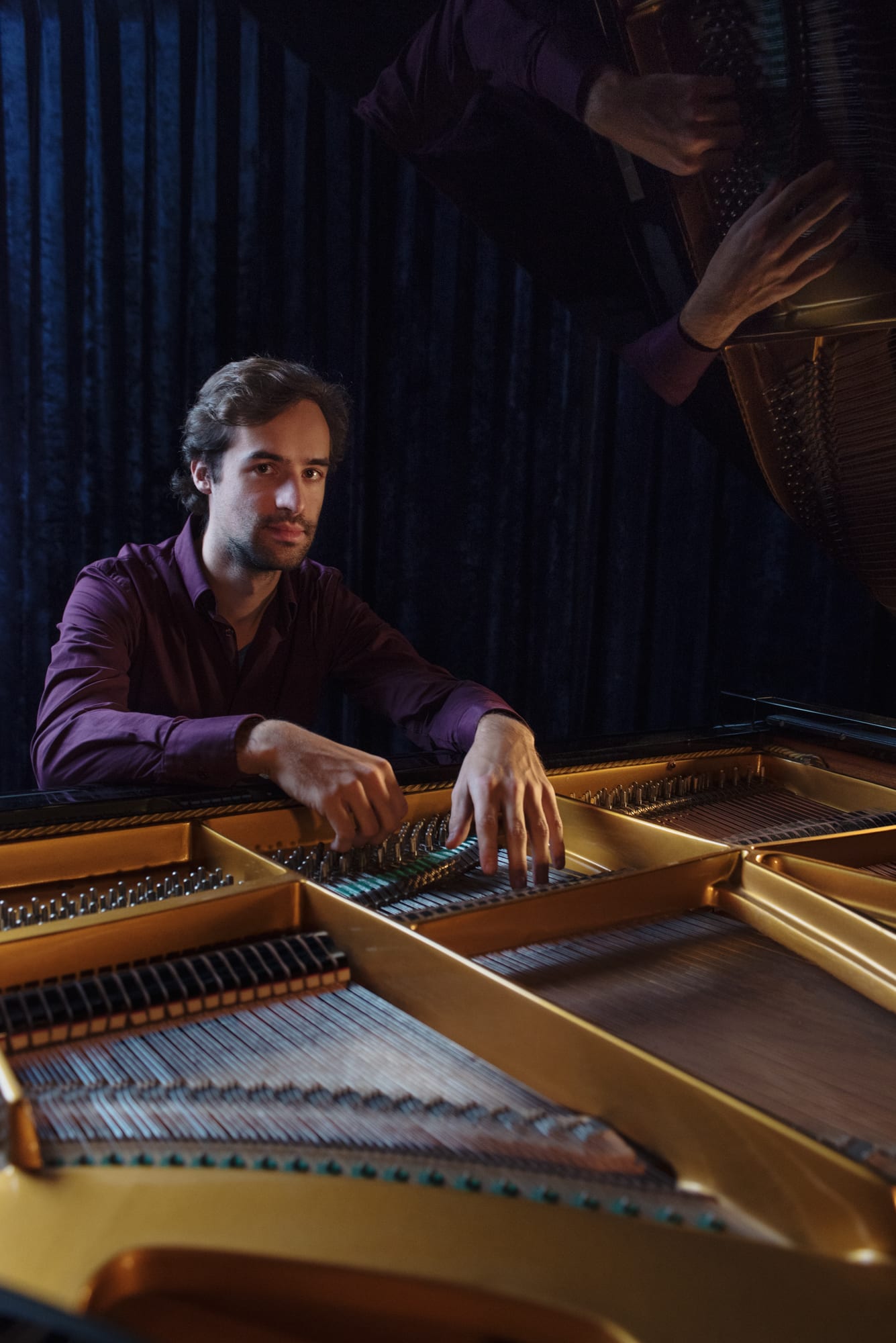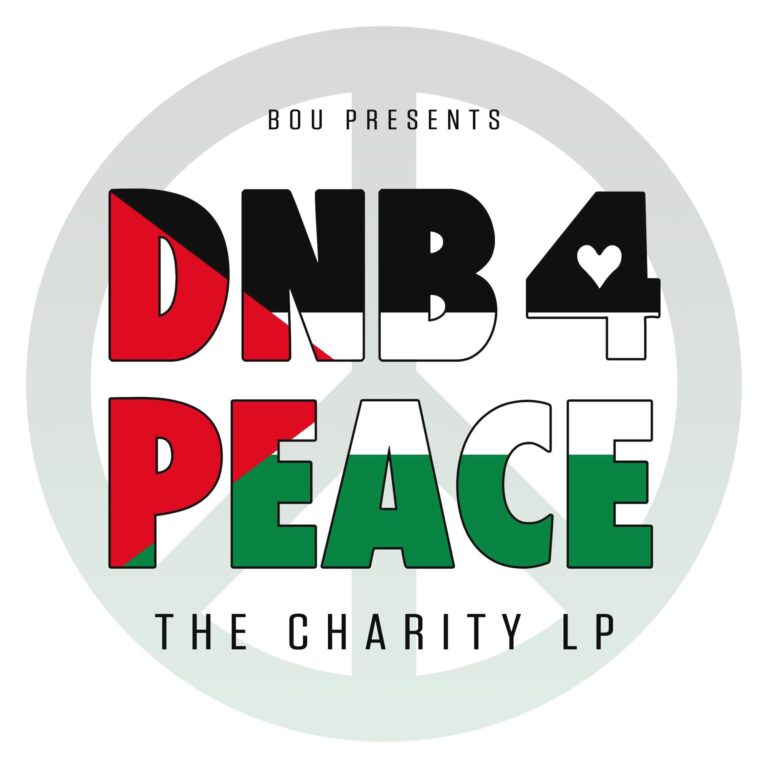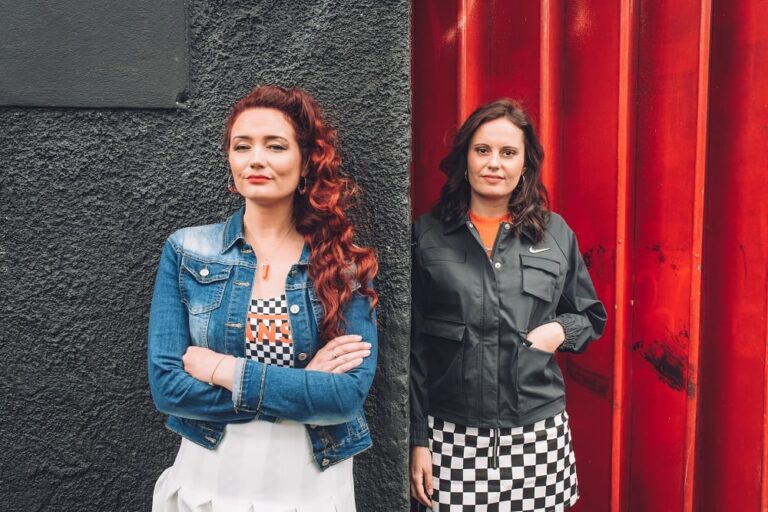From piano ballads and orchestras to viral drum and bass compositions, The Fiber Pianist has taken the internet by storm with his reimagined versions of rave favourites. Growing up in a musical family, with a grand piano at the heart of the home, The Fiber Pianist (real name Tijmen Veltman) was immersed in classical music from a young age. After learning to play by ear across every genre imaginable, Tijmen began to learn the art of composing and writing.
When Dutch drum and bass label and event Fiber went looking for a pianist to collaborate with, Tijmen found himself in the midst of an entirely foreign genre of music. Having never listened to drum and bass before, he was now tasked with recreating and composing classical arrangements of well-loved bass tunes. With his perfect pitch and talent for instrumentals, what followed was an entirely new way to enjoy electronic music.
As the melodic keys of the piano reimagined the sound of Macky Gee – Tour, reaching hundreds of thousands across the world, Fiber and Tijmen decided to take the cocktail of classically arranged drum and bass to the next level by recruiting a whole band. From there, the Polyphonic concept was born – a live 15 member drum and bass band fusing a wide range of genres from jazz to metal. Ahead of their debut post COVID show this weekend in Nijmegen, UKF caught up with Tijmen and Fiber founder Rafael (AKA Rafiki) to find out how they’re trying to bring a whole new musical dimension to the genre.
Let’s start at the beginning of your musical journey as a pianist – when did you start to learn the piano?
Tijmen: I started learning the piano when I was five. I grew up in a house where both of my parents also played the piano, so we had this big grand piano that I loved as a kid and I learnt how to play that as soon as possible. At age five I started taking piano lessons and got mostly into classical music. I did at some point also try to look beyond the classical as well and I started to go into other genres and some more modern musical like rock, pop and electronic. I learnt some other instruments as well – I started taking up guitar, bass and singing to try and branch out a little bit, but piano remained my favourite.
Fast forward to a couple of years ago I met Rafael, who was already very much into drum and bass. I had personally heard of it but was not familiar with it. We wanted to see if there was something we could combine between my background of classical and Rafael’s background in drum and bass and try to create something new. We did that and are still expanding on that now, starting out with just me on the piano but then trying to add more and more instruments into that and more and more different musicians and styles to see what kind of ways we can transform drum and bass music.
Rafael – what were your thoughts when you met Tijmen and what was did you envisage as part of the Fiber brand?
Rafael: At Fiber we believe that uniting people is the most important function of music, so we try to incorporate connection in everything we do. At first, we focused on connecting drum and bass fans. For example, each partygoer at our events gets a wristband with a random number. Every number exists twice, and your goal of the night is to find your buddy. This way, everyone is talking with everyone to find their partner.
The idea for The Fiber Pianist came up when we wanted to further push the connective quality of music. We had this wacky idea of bringing two groups together who couldn’t be less alike and went for bass heads and classical music enthusiasts to see if we could get them in the same place enjoying the same thing. I started looking for a classical pianist for a drum and bass piano concert and eventually linked up with Tijmen. We’ve been working together ever since!
A full circle moment for Fiber, from bringing two numbers together to bringing two entirely different genres together. You sound like you have always been a performer Tijmen – do you find the performative side of music is really important since you do a lot of performances on YouTube, twitch and live shows?
Tijmen: Absolutely. I think that music has different aspects; there is a writing side, recording side and a performing side. I would not want to have one without the other, but the performing side is certainly very important. It is the ultimate test to get first-hand feedback on what you are doing and direct responses from the audience. To witness that and see them reacting to something you have envisioned and then performed to them, that is the real beauty to me.
Speaking of reaction, have you been surprised by the reaction to this concept? One of your shows sold out super quick didn’t it?
Tijmen: I was pleasantly surprised. I believe that there was some live footage from that first concert, one particular song was Tour by Macky Gee, which I did not know of before I started this collaboration and the song is loved more than I could have anticipated. There was a great reception and the videos were viewed by hundreds of thousands of people. It was really something special to see that many people respond to what I have done.
Rafael: I thought there was potential in this, but never in my wildest dreams did I think it would pop off this quickly. I posted the video in DnB Talk and within an hour it completely exploded. I got a message from Macky Gee personally asking if he could share it and it was one of the best performing posts of the year on DnB Allstars. We even got requests from big clubs in the UK asking if we could do a piano concert – it was crazy!
I suppose it can be a bit surreal when it goes from a small idea to having foreigners asking you to come and play piano in a nightclub… I want to talk a bit more about Polyphonic. Tell us a bit more about the concept of Polyphonic – what it involves, what are the performances like?
Rafael: Polyphonic is a homage to drum and bass, and an experiment to see what drum and bass can sound like if you let top-class musicians have their way with it. The band consists of the drummer for Armin van Buuren and one of the most prestigious orchestras in The Netherlands, so I’m very excited to finally experience it. Tijmen has mixed in all kinds of genres like classical, hip hop, Latin, jazz and even metal, to meet with drum and bass in this show.
Tijmen: It’s really a different way to try and transform drum and bass, not just with solo piano but with 10-15 different instruments joining us. That is a new step but a very exciting one that will allow us to have a much broader bandwidth than just the piano. I’ve had a lot of fun writing parts for this and seeing how to make one drum and bass song sound like a completely different genre and what that would mean for other musicians who are used to playing classical. It is a bit of an experimentation but so far what we have seen in the rehearsals it is going very well and I am happy with what they have been able to make of my writing.
Rafael: It’s kind of funny. I initially contacted Tijmen as a pianist, but as we were getting to know each other I was learning how multitalented this guy is. Tijmen can play bass, double bass, guitar, saxophone, he can sing – and on top of that he can compose full orchestras. All of these things that I did not know until we started this project!

You both describe it as an experiment. When we think of an experiment there are always challenges and benefits to be discovered – what have these been for you so far Tijmen?
Tijmen: What I set out to do was arrange music in a way that people would instantly recognise the original and do the original song justice, but also make something new that sounds cool in its own right and make it playable for the specific instruments. That can be difficult because even though these musicians are top notch professionals and very capable, there are just some things that are physically impossible. There are some long notes or melodies where at some point a trumpet player needs to breathe, so we cannot really stretch it for too long. Those are the kinds of things you really have to work around and see if I can come up with a solution.
It does force you to think of new ideas in the process, for example we would divide melodies into different melodies and echo each other in a way, which actually reaches the exact goal of making it sound recognisable but new, which was born out of necessity but turned out to be very cool.
When you were bringing the idea of Polyphonic to life, you were planning it as a live piano show, but then the pandemic hit. Do you think it has helped to have the lockdowns as you have been able to develop the idea further?
Rafael: When we had our piano concert in London concert cancelled due to COVID, that was rough. The idea was to build from that concert and expand, so that all went down the drain. But interestingly, the Dutch performing arts fund actually released a subsidy for coronavirus-proof projects. We got one of those subsidies and that is what has Polyphonic possible, so in that sense COVID has actually helped us gain capabilities to develop a show this big, which is a blessing.
Tijmen: Of course, when you cancel a show last minute it a shame. We spoke about the performing aspect of music and that is something that I have been missing very much over the last year and a half, but on the other hand it did allow us more introspective time to see what we could do with this when we get the chance, and what kind of work can we do to make that possible. In this case, I really had some extra time to do my homework and think of these new transformations and new instrumentations that other could people play.
One of the Polyphonic’s objectives is to encourage more use of instruments in the genre of drum and bass. Tijmen, what do you think instruments played by humans can bring to drum and bass where it is predominantly computer-generated?
Tijmen: I think they can add a human interpretation of a melody that I do not think we have been able to replicate using technology, as far as I know. This is also something that you learn a lot about when you are interpreting classical music – how to make any note sound interesting. Often the key is to not play it homogenously, but to play around slightly with the timing, rhythm, intensity and volume and that is what a musician often does subconsciously. It gives that extra feeling and human irregularities to make the music come to life.
Is there a specific performance or creation that has been your favourite so far, or even the most unique?
Tijmen: Looking back I certainly have some favourites now. One of them I would like to mention is Strobe, which we have been playing a lot, specifically the remix by Dimension. This is one of my personal favourites in the sense that I think it is a pretty long song which is all instrumental but it has the very big range that starts out really quietly with one single instrument and just a couple of notes going back and forth, but it builds on that and gets bigger and bigger over the eight minutes. It adds more and more layers and I find it very beautiful, and it is the song we opened the first concert with to set the mood. It is also one that we will be including in Polyphonic where we bring extra layering to the song with the actual strings, trumpets, horns and percussion into the mix. I think it allows for that classic orchestral interpretation very well despite not being a classical song at all.
I’ve also gotten to know a lot of Camo & Krooked songs which I find very beautiful, one in particular we did was Ember, which similarly has a lot of different layers that starts of calmly but adds more and more until you have an orchestral sized song that is not being played by an orchestra. That is one of my favourites to listen to and also play. Camo & Krooked actually allowed us to cover Ember officially.
What are the plans going forward as Fiber, The Fiber Pianist or the Polyphonic concept?
Tijmen: We just want to keep expanding and see where else we can take drum and bass music. I’d love to help other drum and bass artists in creating live shows or incorporate live elements in their music. I also plan to write music with drum and bass producers and release a solo piano cover album. As for Polyphonic, we would love to perform our material at drum and bass clubs and festivals, or even write new material for a special occasion.
Rafael: As Fiber we would love to host or facilitate live shows from drum and bass artists. We’ve had Keeno play live piano for the first time ever at Fiber and it was a huge success, and we have a few more debut live shows in the pipeline. We are also building a network of drum and bass specialised instrumentalists, so it becomes easier for producers to add live elements in their songs. We already have a violinist, double bass player, guitarist, trumpet player and even a beatboxer! We are still expanding, so if there are any talented instrumentalists reading, we would love to hear from you!
July 3 : Polyphonic Live : Fiber Pianist, T & Sugah, Rafiki : Doornroosje, Nijmegen


